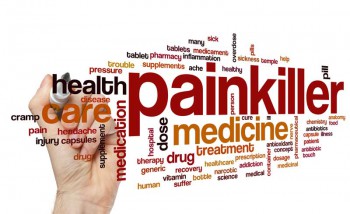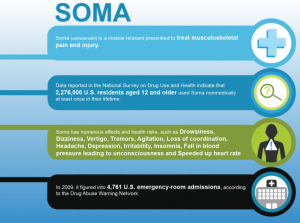Soma Carisoprodol Addiction & Abuse Statistics

As the pharmaceutical industry continues to make and develop drugs that are readily and easily prescribed by doctors, we will continue to see a rise in the addiction and abuse statistics of these drugs. Soma, a skeletal muscle relaxant, is one of these drugs that continues to see a rise in popularity among those who actively seek to abuse the drug to achieve a level of euphoria or high that is consistent with prescription drug abuse. The Soma addiction and abuse statistics show those who are prescribed the drug are more likely to begin to abuse it if it is used for an extended period of time and/or it is used by someone with a prior history of substance abuse. Keep reading to learn more about Soma addiction and abuse statistics.
What is Soma?
Before we dive into the Soma addiction and abuse statistics, let’s talk about what Soma is, how it works and why it can cause some users to become addicted. Soma is the trade name for the drug Carisoprodol. It’s a non-controlled skeletal muscle relaxant. Soma works by blocking pain sensations between the brain and the body’s nerves. It is used to help treat major injuries and musculoskeletal damage. While it is not a narcotic like other drugs that carry addictive properties, it is similar in its effects, which is why it can be habit forming. Because of the way the pain receptors are blocked, the body does build up a physical tolerance to the drug. This means, over-time, the user needs to take more of the drug in order to see the same effects of muscle relaxation.
The active ingredient in the drug is a metabolite called Meprobamate. Meprobamate is a schedule IV controlled substance. Meprobamate is often what drug users seek out of the drug to help them achieve their high.
When the pharmaceutical companies first released the drug, many doctors and physicians did not realize the potential dangers surrounding Soma with it’s active metabolic ingredient and its potential for abuse, according to the American Journal for Drug and Alcohol Abuse. As a result, the drug was widely distributed and prescribed to patients. This made it easier for abusers to get their hands on the drug.
Soma Addiction and Abuse Statistics:
- Abuse statistics of Soma show that those who use the drug for three months or longer have a higher risk of developing an addiction to Soma. Those who have a prior history of drug abuse and addiction might find they become addicted to Soma even quicker than those who don’t.
- Data from the National Survey on Drug Use and Health showed that 2.5 million people ages 12 and older reported using Soma for non-medical purposes at least once in their life, according to a 2007 survey.
- States like Arizona and California, which are close to the Mexican border where drugs like Soma are easier to illegally procure, have seen the highest rates of abuse of Soma.
- Street drug names for Soma include: DS, Dance, Las Vegas Cocktail and Soma Coma (a combo of Soma and Codeine).
- Overdosing on Soma can result in death.
Soma Abuse:
- When Soma is taken in quantities surpassing the recommended dosages by doctors, it can result in an effect similar to dizziness, giddiness and relaxation. If the drug is taken in combination with other drugs like codeine, vicodin or even alcohol, it can produce exasperated results and can also result in a deadly combination for the user.
- A Soma Coma is a popular way to abuse the drug when it is combined with Codeine. Users report feeling disoriented, extremely dizzy, but relaxed. Often times the user passes out and is unable to function normally, can barely walk and talk. Results of a Soma Coma can often lead to serious risks for the user including death.
- Like other illegal drugs, the Mexican drug cartel is a big carrier of Soma, which can also be purchased from some less-than-reputable doctors and pharmacists in Mexico, according to information from the U.S. Justice Department.
While doctors and medical professionals should exercise restraint and caution in prescribing a drug like Soma, those patients who do take the drug should be aware of potential signs of Soma addiction so they can be sure to consult with their doctor to ease the dependency as soon as it begins – combating the addiction early. Those who may have abused Soma intentionally but now find themselves looking to get on the road to recovery, there are drug abuse treatment programs and rehabs available. Be sure to consult a medical professional right away if you or someone you know is addicted to Soma.
Sources: Drugs.com, justice.gov, detoxtorehab.com





